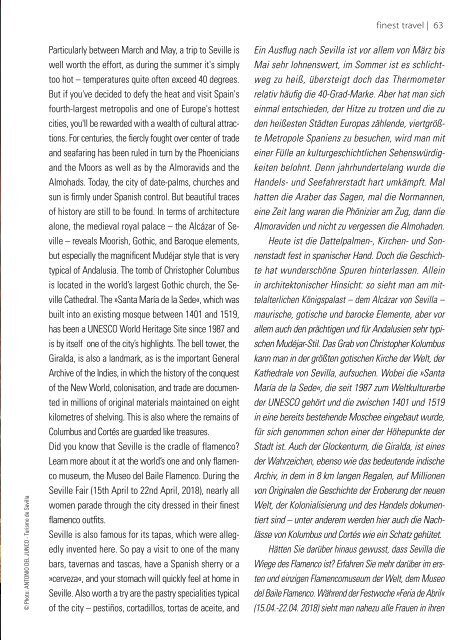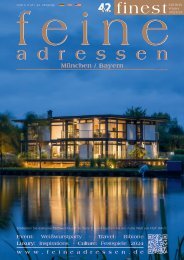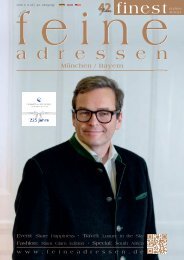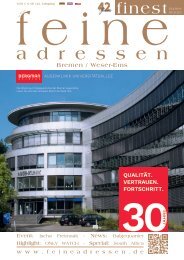Marbella 1 18
Erfolgreiche ePaper selbst erstellen
Machen Sie aus Ihren PDF Publikationen ein blätterbares Flipbook mit unserer einzigartigen Google optimierten e-Paper Software.
finest travel | 63<br />
© Photo: ANTONIO DEL JUNCO - Turismo de Sevilla<br />
Particularly between March and May, a trip to Seville is<br />
well worth the effort, as during the summer it's simply<br />
too hot – temperatures quite often exceed 40 degrees.<br />
But if you've decided to defy the heat and visit Spain's<br />
fourth-largest metropolis and one of Europe's hottest<br />
cities, you'll be rewarded with a wealth of cultural attractions.<br />
For centuries, the fiercly fought over center of trade<br />
and seafaring has been ruled in turn by the Phoenicians<br />
and the Moors as well as by the Almoravids and the<br />
Almohads. Today, the city of date-palms, churches and<br />
sun is firmly under Spanish control. But beautiful traces<br />
of history are still to be found. In terms of architecture<br />
alone, the medieval royal palace – the Alcázar of Seville<br />
– reveals Moorish, Gothic, and Baroque elements,<br />
but especially the magnificent Mudéjar style that is very<br />
typical of Andalusia. The tomb of Christopher Columbus<br />
is located in the world’s largest Gothic church, the Seville<br />
Cathedral. The »Santa María de la Sede«, which was<br />
built into an existing mosque between 1401 and 1519,<br />
has been a UNESCO World Heritage Site since 1987 and<br />
is by itself one of the city’s highlights. The bell tower, the<br />
Giralda, is also a landmark, as is the important General<br />
Archive of the Indies, in which the history of the conquest<br />
of the New World, colonisation, and trade are documented<br />
in millions of original materials maintained on eight<br />
kilometres of shelving. This is also where the remains of<br />
Columbus and Cortés are guarded like treasures.<br />
Did you know that Seville is the cradle of flamenco?<br />
Learn more about it at the world’s one and only flamenco<br />
museum, the Museo del Baile Flamenco. During the<br />
Seville Fair (15th April to 22nd April, 20<strong>18</strong>), nearly all<br />
women parade through the city dressed in their finest<br />
flamenco outfits.<br />
Seville is also famous for its tapas, which were allegedly<br />
invented here. So pay a visit to one of the many<br />
bars, tavernas and tascas, have a Spanish sherry or a<br />
»cerveza«, and your stomach will quickly feel at home in<br />
Seville. Also worth a try are the pastry specialities typical<br />
of the city – pestiños, cortadillos, tortas de aceite, and<br />
Ein Ausflug nach Sevilla ist vor allem von März bis<br />
Mai sehr lohnenswert, im Sommer ist es schlichtweg<br />
zu heiß, übersteigt doch das Thermometer<br />
relativ häufig die 40-Grad-Marke. Aber hat man sich<br />
einmal entschieden, der Hitze zu trotzen und die zu<br />
den heißesten Städten Europas zählende, viertgrößte<br />
Metropole Spaniens zu besuchen, wird man mit<br />
einer Fülle an kulturgeschichtlichen Sehenswürdigkeiten<br />
belohnt. Denn jahrhundertelang wurde die<br />
Handels- und Seefahrerstadt hart umkämpft. Mal<br />
hatten die Araber das Sagen, mal die Normannen,<br />
eine Zeit lang waren die Phönizier am Zug, dann die<br />
Almoraviden und nicht zu vergessen die Almohaden.<br />
Heute ist die Dattelpalmen-, Kirchen- und Sonnenstadt<br />
fest in spanischer Hand. Doch die Geschichte<br />
hat wunderschöne Spuren hinterlassen. Allein<br />
in architektonischer Hinsicht: so sieht man am mittelalterlichen<br />
Königspalast – dem Alcázar von Sevilla –<br />
maurische, gotische und barocke Elemente, aber vor<br />
allem auch den prächtigen und für Andalusien sehr typischen<br />
Mudéjar-Stil. Das Grab von Christopher Kolumbus<br />
kann man in der größten gotischen Kirche der Welt, der<br />
Kathedrale von Sevilla, aufsuchen. Wobei die »Santa<br />
María de la Sede«, die seit 1987 zum Weltkulturerbe<br />
der UNESCO gehört und die zwischen 1401 und 1519<br />
in eine bereits bestehende Moschee eingebaut wurde,<br />
für sich genommen schon einer der Höhepunkte der<br />
Stadt ist. Auch der Glockenturm, die Giralda, ist eines<br />
der Wahrzeichen, ebenso wie das bedeutende indische<br />
Archiv, in dem in 8 km langen Regalen, auf Millionen<br />
von Originalen die Geschichte der Eroberung der neuen<br />
Welt, der Kolonialisierung und des Handels dokumentiert<br />
sind – unter anderem werden hier auch die Nachlässe<br />
von Kolumbus und Cortés wie ein Schatz gehütet.<br />
Hätten Sie darüber hinaus gewusst, dass Sevilla die<br />
Wiege des Flamenco ist? Erfahren Sie mehr darüber im ersten<br />
und einzigen Flamencomuseum der Welt, dem Museo<br />
del Baile Flamenco. Während der Festwoche »Feria de Abril«<br />
(15.04.-22.04. 20<strong>18</strong>) sieht man nahezu alle Frauen in ihren


















